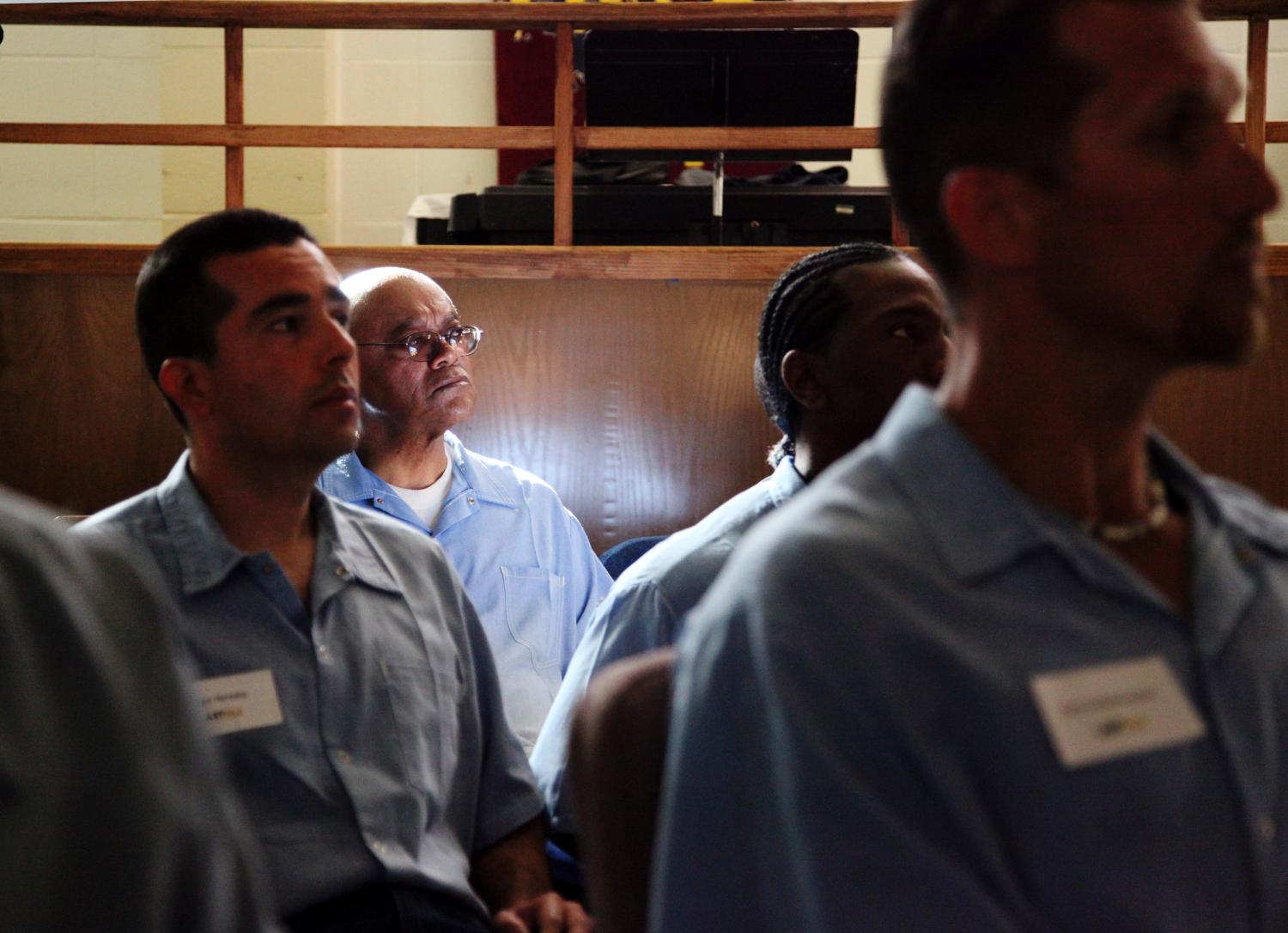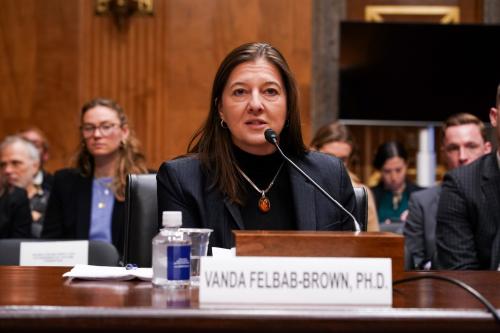Below is the third chapter from “A Better Path Forward for Criminal Justice,” a report by the Brookings-AEI Working Group on Criminal Justice Reform. You can access other chapters from the report here.
Prison culture and environment are essential to public health and safety. While much of the policy debate and public attention of prisons focuses on private facilities, roughly 83 percent of the more than 1,600 U.S. facilities are owned and operated by states.1 This suggest that states are an essential unit of analysis in understanding the far-reaching effects of imprisonment and the site of potential solutions. Policy change within institutions has to begin at the state level through the departments of corrections. For example, California has rebranded their state corrections division and renamed it the California Department of Corrections and Rehabilitation. For many, these are not only name changes but shifts in policy and practice. In this chapter, we rethink the treatment environment of the prison by highlighting strategies for developing cognitive behavioral communities in prison—immersive cognitive communities. This new approach promotes new ways of thinking and behaving for both incarcerated persons and correctional staff. Behavior change requires changing thinking patterns and cognitive behavioral therapy (CBT) is an evidence-based strategy that can be utilized in the prison setting. We focus on short-, medium-, and long-term recommendations to begin implementing this model and initiate reforms for the organizational structure of prisons.
Level Setting
The U.S. has seen a steady decline in the federal and state prison population over the last eleven years, with a 2019 population of about 1.4 million men and women incarcerated at year-end, hitting its lowest level since 1995.2 With the COVID-19 pandemic in 2020, criminal justice reformers have urged a continued focus on reducing prison populations and many states are permitting early releases of nonviolent offenders and even closing prisons. Thus, we are likely to see a dramatic reduction in the prison population when the data are tabulated for 2020.
However, it is undeniable that the U.S. will continue to use incarceration as a sanction for criminal behavior at a much higher rate than in other Western countries, in part because of our higher rate of violent offenses. Consequently, a majority of people incarcerated in the U.S. are serving a prison sentence for a violent offense (58 percent). The most serious offense for the remainder is property offenses (16 percent), drug offenses (13 percent), or other offenses (13 percent; generally, weapons, driving offenses, and supervision violations).3 Moreover, the majority of people in U.S. prisons have been previously incarcerated. The prison population is largely drawn from the most disadvantaged part of the nation’s population: mostly men under age 40, disproportionately minority, with inadequate education. Prisoners often carry additional deficits of drug and alcohol addictions, mental and physical illnesses, and lack of work experience.4
According to data compiled by the U.S. Bureau of Justice Statistics, the average sentence length in state courts for those sentenced to confinement in a state prison is about 4 years and the average time served is about 2.5 years. Those sentenced for a violent offense typically serve about 4.7 years with persons sentenced for murder or manslaughter serving an average of 15 years before their release.5 Thus, it is important to consider the conditions of prison life in understanding how individuals rejoin society at the conclusion of their sentence. Are they prepared to be valuable community members? What lessons have they learned during their confinement that may help them turn their life around? Will they be successful in avoiding a return to prison? What is the most successful path for helping returning citizens reintegrate into their communities?
Regrettably, prison life is often fraught with difficulty. Being sentenced to incarceration can be traumatic, leading to mental health disorders and difficulty rejoining society. Incarcerated individuals must adjust to the deprivation of liberty, separation from family and social supports, and a loss of personal control over all aspects of one’s life. In prison, individuals face a loss of self-worth, loneliness, high levels of uncertainty and fear, and idleness for long periods of time. Imprisonment disrupts the routines of daily life and has been described as “disorienting” and a “shock to the system”.6 Further, some researchers have described the existence of a “convict code” in prison that governs behavior and interactions with norms of prison life including mind your own business, no snitching, be tough, and don’t get too close with correctional staff. While these strategies can assist incarcerated persons in surviving prison, these tools are less helpful in ensuring successful reintegration.
Thus, the entire prison experience can jeopardize the personal characteristics required to be effective partners, parents, and employees once they are released. Coupled with the lack of vocational training, education, and reentry programs, individuals face a variety of challenges to reintegrating into their communities. Successful reintegration will not only improve public safety but forces us to reconsider public safety as essential to public health.
Despite the toll of difficult conditions of prison, people who are incarcerated believe that they can be successful citizens. In surveys and interviews with men and women in prison, the majority express hope for their future. Most were employed before their incarceration and have family that will help them get back on their feet. Many have children that they were supporting and want to reconnect with. They realize that finding a job may be hard, but they believe they will be able to avoid the actions that got them into trouble, principally committing crimes and using illegal substances.7 Research also shows that most individuals with criminal records, especially those convicted of violent crimes, were often victims themselves. This complicates the “victim”-“offender” binary that dominates the popular discourse about crime. By moving beyond this binary, we propose cognitive behavioral therapy, among a host of therapeutic approaches, as part of a broader restorative approach.
Despite having histories of associating with other people who commit crimes and use illegal drugs, incarcerated individuals have pro-social family and friends in their lives. They also may have some personality characteristics that make it difficult to resist involvement in criminal behavior, including impulsivity, lack of self-control, anger/defiance, and weak problem-solving and coping skills. Psychologists have concluded that the primary individual characteristics influencing criminal behavior are thinking patterns that foster criminal activity, associating with other people who engage in criminal activity, personality patterns that support criminal activity, and a history of engaging in criminal activity.8 While the context constrains individual behavior and choices, the motivation for incarcerated individuals to change their behavior is rooted in their value of family and other positive relationships. However, most prison environments pose significant challenges for incarcerated individuals to develop motivation to make positive changes. Interpersonal relationships in prison are difficult as there is often a culture of mistrust and suspicion coupled with a profound absence of empathy. Despite these challenges, cognitive behavioral interventions can provide a successful path for reintegration.
Many psychologists believe that changing unwanted or negative behaviors requires changing thinking patterns since thoughts and feelings affect behaviors. Cognitive behavioral therapy (CBT) emerged as a psycho-social intervention that helps people learn how to identify and change destructive or disturbing thought patterns that have a negative influence on behavior and emotions. It focuses on challenging and changing unhelpful cognitive distortions and behaviors, improving emotional regulation, and developing personal coping strategies that target solving current problems.9 In most cases, CBT is a gradual process that helps a person take incremental steps towards a behavior change. CBT has been directed at a wide range of conditions including various addictions (smoking, alcohol, and drug use), eating disorders, phobias, and problems dealing with stress or anxiety. CBT programs help people identify negative thoughts, practice skills for use in real-world situations, and learn problem-solving skills. For example, a person with a substance use disorder might start practicing new coping skills and rehearsing ways to avoid or deal with a high-risk situation that could trigger a relapse.
Since criminal behavior is driven partly by certain thinking patterns that predispose individuals to commit crimes or engage in illegal activities, CBT helps people with criminal records change their attitudes and gives them tools to avoid risky situations. Cognitive behavioral therapy is a comprehensive and time-consuming treatment, typically, requiring intensive group sessions over many months with individualized homework assignments. Evaluations of CBT programs for justice-involved people found that cognitive restructuring treatment was significantly effective in reducing criminal behavior, with those receiving CBT showing recidivism reductions of 20 to 30 percent compared to control groups.10 Thus, the widespread implementation of cognitive behavioral therapy as part of correctional programming could lead to fewer rearrests and lower likelihood of reincarceration after release. CBT can also be used to mitigate prison culture and thus help reintegrate returning citizens back into their communities.
Thus, the widespread implementation of cognitive behavioral therapy as part of correctional programming could lead to fewer rearrests and lower likelihood of reincarceration after release.
Even the most robust CBT program that meets three hours per week leaves 165 hours a week in which the participant is enmeshed in the typical prison environment. Such an arrangement is bound to dilute the therapy’s impact. To counter these negative influences, the new idea is to connect CBT programming in prison with the old idea of therapeutic communities. Therapeutic communities—either in prison or the community—were established as a self-help substance use rehabilitation approach and instituted the idea that separating the target population from the general population would allow a pro-social community to develop and thereby discourage antisocial cognitions and behaviors. The therapeutic community model relies heavily on participant leadership and requires participants to intervene in arguments and guide treatment groups. Inside prisons, therapeutic communities are a separate housing unit that fosters a rehabilitative environment.
Cognitive Communities in prison would be an immersive experience in cognitive behavioral therapy involving cognitive restructuring, anti-criminal modeling, skill building, problem-solving, and emotion management. These communities would promote new ways of thinking and behaving among its participants around the clock, from breakfast in the morning through residents’ daily routines, including formal CBT sessions, to the evening meal and post-dinner activities. Blending the best aspects of therapeutic communities with CBT principles would lead to Cognitive Communities with several key elements: a separate physical space, community participation in daily activities, reinforcement of pro-social behavior, use of teachable moments, and structured programs. This cultural shift in prison organization provides a foundation for restorative justice practices in prisons.
Accordingly, our recommendations include:
Short-Term Reforms
- Create Transforming Prisons Act
- Accelerate Decarceration Begun During Pandemic
Medium-Term Reforms
- Encourage Rehabilitative Focus in State Prisons
- Foster Greater Use of Community Sanctions
Long-Term Reforms
- Embrace Rehabilitative/Restorative Community Justice Models
- Encourage Collaborations between Corrections Agencies and Researchers
SHORT-TERM REFORMS
Create Transforming Prisons Act
To begin transforming prisons to help prisons and people change, a new funding opportunity for state departments of correction is needed. We propose the Transforming Prisons Act (funded through the Department of Justice’s Bureau of Justice Assistance) which would permit states to apply for funds to support innovative programs and practices that would improve prison conditions both for the people who live in prisons and work in prisons. This dual approach would begin to transform prisons into a more just and humane experience for both groups. These new funds could support broad implementation of Cognitive Communities by training the group facilitators and the correctional staff assigned to the specialized prison units. Funds could also be used to broaden other therapeutic programming to support individuals in improving pro-social behaviors through parenting classes, family engagement workshops, anger management, and artistic programming. One example is the California Transformative Arts which promotes self-awareness and improves mental health through artistic expression. Together, these programs could mark a rehabilitative turn in corrections.
Accelerate Decarceration Begun During Pandemic
While we work to change policies and practices to make prisons more humane, we also need to work towards decarceration. The COVID-19 crisis has enabled innovations in diverting and improving efforts to reintegrate returning citizens in the U.S. During the pandemic, many states took bold steps in implementing early release for older incarcerated persons especially those with health disorders. Research shows that returning citizens of advanced age and with poor health conditions are far less likely to commit crime after release. This set of circumstances makes continued diversion and reintegration of this population a much wiser investment than incarceration.
MEDIUM-TERM REFORMS
Encourage Rehabilitative Focus in State Prisons
In direct response to calls to abolish prisons and defund the police, state prisons should move away from focusing on incapacitation to rehabilitation. To assist in this change, federal funds should be tied to embracing a rehabilitative mission to transform prisons. This transformation should be rooted in evidence-based therapeutic programming, documenting impacts on both incarcerated individuals and corrections staff. Prison good-time policies should be revisited so that incarcerated individuals receive substantial credit for participating in intensive programming such as Cognitive Communities. With a backdrop of an energized rehabilitative philosophy, states should be supported in their efforts to implement innovative models and programming to improve the reintegration of returning citizens and change the organizational structure of their prisons.
In direct response to calls to abolish prisons and defund the police, state prisons should move away from focusing on incapacitation to rehabilitation.
Foster Greater Use of Community Sanctions
As the country with the highest incarceration rate in the world, current U.S. incarceration policies and practices are costly for families, communities, and state budgets. Openly punitive incarceration policies make it exceedingly difficult for incarcerated individuals to successfully reintegrate into communities as residents, family members, and employees. A long-term policy goal in the U.S. must be to reduce our over-reliance on incarceration through shorter prison terms, increased reliance on community sanctions, and closing prisons. The COVID-19 pandemic revealed that decarceration poses minimal risk to community safety. Given this steady decline in the prison population and decline in prison building in the U.S. since 2000, we encourage other types of development in rural communities to loosen the grip of prisons in these areas. Alternative development for rural communities is important because the most disadvantaged rural communities are both senders of prisoners and receivers of prisons with roughly 70 percent of prison facilities located in rural communities.
LONG-TERM REFORMS
Embrace Rehabilitative/Restorative Community Justice Models
Public safety and public health goals can be achieved through Community Justice Centers—these are sites that act as a diversion preference for individuals who may be in a personal crisis due to mental health conditions, substance use, or family trauma. Recent research demonstrates that using social or public health services to intervene in such situations can lead to better outcomes for communities than involving the criminal justice system. To be clear, many situations can be improved by crisis intervention expertise specializing in de-escalation rather than involving the justice system which may have competing objectives. Community Justice Centers are nongovernmental organizations that divert individuals in crisis away from law enforcement and the justice system. Such diversion also helps ease the social work burden on the justice system that it is often ill-equipped to handle.
Encourage Collaborations between Corrections Agencies and Researchers
Researchers and corrections agencies need to develop working relationships to permit the study of innovative organizational approaches. In the past, the National Institute of Justice created a researcher-practitioner partnership program, whereby local researchers worked with criminal justice practitioners (generally, law enforcement) to develop research projects that would benefit local criminal justice agencies and test innovative solutions to local problems. A similar program could be announced to help researchers assist corrections agencies and officials in identifying research projects that could address problems facing prisons and prison officials (e.g., safety, staff burnout, and prisoner grievance procedures).
Recommendations for Future Research
Some existing jail and prison correctional systems are implementing broad organization changes, including immersive faith-based correctional programs, jail-based 60- to 90-day reentry programs to prepare individuals for their transition to the community, Scandinavian and other European models to change prison culture, and an innovative Cognitive Community approach operating in several correctional facilities in Virginia. However, these efforts have not been rigorously evaluated. New models could be developed and tested widely, preferably through randomized controlled trials, and funded by the research arm of the Department of Justice, the National Institute of Justice (NIJ), or various private funders, including Arnold Ventures.
Correctional agencies in some states may be ready to implement the Cognitive Community model using a separate section of a prison or smaller facility not in use. Funding is needed to evaluate these pilot efforts, assess fidelity to the model standards, identify challenges faced in implementing the model, and propose any modifications to improve the proposed Cognitive Community model. Full-scale rigorous tests of the Cognitive Community model are needed which would randomly assign eligible inmates to the Cognitive Community environment or to continue to carry out their sentence in a regular prison setting. Ideally, these studies would observe the implementation of the program, assess intermediate outcomes while participants are enrolled in the program, follow participants upon release and examine post-release experiences in the post-release CBT program, and then assess a set of reentry outcomes at several intervals for at least one year after release.
Conclusion
Prison culture and environment are essential to community public health and safety. Incarcerated individuals have difficulty successfully reintegrating into their communities after release because the environment in most U.S. prisons is not conducive to positive change. Normalizing prison environments with evidence-based programming, including cognitive behavioral therapy, education, and personal development, will help incarcerated individuals lead successful lives in the community as family members, employees, and community residents. States need to move towards less reliance on incarceration and more attention to community justice models.
Recommended Readings
Eason, John M. 2017. Big House on the Prairie: Rise of the Rural Ghetto and Prison Proliferation. Chicago, IL: Univ of Chicago Press.
Travis, J., Western, B., and Redburn, S. (Eds.). 2014. The Growth of Incarceration in the United States: Exploring Causes and Consequences. National Research Council; Division of Behavioral and Social Sciences and Education; Committee on Law and Justice; Committee on Causes and Consequences of High Rates of Incarceration. Washington, DC: National Academies Press.
Orrell, B. (Ed). 2020. Rethinking Reentry. Washington, DC: American Enterprise Institute.
Mitchell, Meghan M., Pyrooz, David C., & Decker, Scott. H. 2020. “Culture in prison, culture on the street: the convergence between the convict code and code of the street.” Journal of Crime and Justice. DOI: 10.1080/0735648X.2020.1772851.
Haney, C. 2002. “The Psychological Impact of Incarceration: Implications for Post-Prison Adjustment.” https://aspe.hhs.gov/basic-report/psychological-impact-incarceration-implications-post-prison-adjustment.
-
Footnotes
- Eason, John M. 2017. Big House on the Prairie: Rise of the Rural Ghetto and Prison Proliferation. Chicago, IL: Univ of Chicago Press.
- Carson, E. Ann. 2020. Prisoners in 2019. NCJ 255115. Washington, DC: Bureau of Justice Statistics.
- Ibid.
- Travis, Jeremy, Bruce Western, and Steven Redburn, (Eds.). 2014. The Growth of Incarceration in the United States: Exploring Causes and Consequences. National Research Council; Division of Behavioral and Social Sciences and Education; Committee on Law and Justice; Committee on Causes and Consequences of High Rates of Incarceration. Washington, DC: National Academies Press.
- Kaeble, Danielle. 2018. Time Served in State Prison, 2016. NCJ 252205. Washington, DC: Bureau of Justice Statistics.
- Haney, Craig. 2002. “The Psychological Impact of Incarceration: Implications for Post-Prison Adjustment.” Prepared for the Prison to Home Conference, January 30–31, 2002. https://aspe.hhs.gov/basic-report/psychological-impact-incarceration-implications-post-prison-adjustment.
- Visher, Christy and Nancy LaVigne. 2021. “Returning home: A pathbreaking study of prisoner reentry and its challenges.” In P.K. Lattimore, B.M. Huebner, & F.S. Taxman (eds.), Handbook on moving corrections and sentencing forward: Building on the record (pp. 278–311). New York, NY: Routledge.
- Latessa, Edward. 2020. “Triaging services for individuals returning from prison.” In B. Orrell (Ed.), Rethinking Reentry. Washington, DC: American Enterprise Institute.
- Ibid.
- Nana Landenberger and Mark Lipsey. 2005. “The positive effects of cognitive-behavioral programs for offenders: A meta-analysis of factors associated with effective treatment.” Journal of Experimental Criminology, 1, 451–476.





